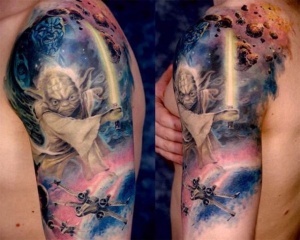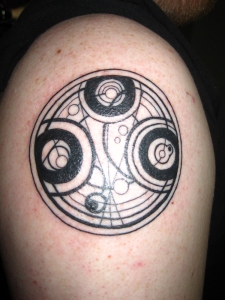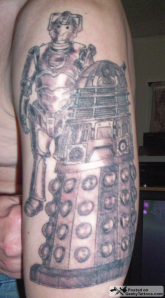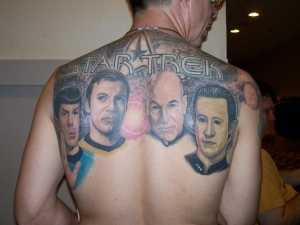Blog Archives
Geek Ink: Geek Tattoos and Consumer Culture
To be geek is no longer an especially unique or stigmatizing proclamation. The term geek is often somewhat sloppily used to refer to a broad range of people with some fervent attraction to something; while it is not necessary to establish an inflexible definition for geek, it seems to distinguish social groups sharing a fervent collective commitment to fan practices and discourses: those might revolve around comics, science fiction, gaming, or nearly any other dimension of popular culture that fashions social interactions and consumption.
In the context of consumer culture being geek risks losing its distinction as marketers package geek symbols for the masses, so geeks aspire to race ahead of the “mainstream,” seeking out the creative, arcane, and specialized and preserving geek distinction before it falls victim to mass marketing. The challenge contemporary subcultures face is to maintain social practices and material style in opposition to a homogenizing marketplace that reduces such practices and things to mass-produced—and commonplace–commodities. Batman, Star Wars, Star Trek, and Spiderman are now brands in the sense that they may be homogenizing marketing symbols as much as they are symbols of distinction or resistance.
Geeks’ distinction is not simply a matter of material consumption: geek standing is secured by informed thinking through and mastery of obscure knowledge, so it is fundamentally social. The notion that such social practices define a “geek culture” risks lapsing into marketing caricatures, and it also hazards a contrived authenticity that poses absolute boundaries between geeks and non-geeks. Nevertheless, there are some genuine social distinctions, and consumption is clearly a key dimension of staking a claim to geek status, with a variety of material culture—t-shirts, toys, posters, shoes—offering up geek symbols recognizable to nearly any audience.
Tattoos are commodities that embed symbolic capital in our skin, rendering our body a consumable sign to be “read,” however tattoos are distinctive consumables. On the one hand, tattoos are commodities that routinely represent popular cultural motifs if not branded symbols, and tattoos no longer represent dramatic deviance from the mainstream (21% of American adults in 2012 had at least one tattoo). On the other hand, tattoos are not mass-produced commodities, and they represent some individually chosen symbolism. Tattoos fabricate consumer selfhood, but they involve individual selection of the symbols, a narrative of the process of getting the tattoo, and genuine permanence.
Science fiction and comics provide many rich franchise symbols. Batman, for instance, provides a host of Bat logos and symbols from comics, the television show, a series of movies, and even games. Like the most cherished sci-fi and comic franchises, a Batman symbol is recognizable beyond the confines of geek circles, but that broad currency risks undermining the symbol’s geek meanings. A geek tattoo is most powerful as subcultural capital when it invokes a novel or obscure symbol distinct to a subcultural collective; in a geek’s skin, these deepest symbols materialize knowledge, creativity, and devotion, if not love.
Much like Batman, Doctor Who provides a host of symbols including the TARDIS, Daleks, K-9, and the Doctors as well as a host of catchphrases for the textually inclined. After over a half-century of programming, Doctor Who symbols are familiar amongst geeks, and a completely unscientific survey of online Who tattoos suggests that the TARDIS is indeed the most common motif amongst Who tattoos. The TARDIS has the attraction of providing a form a consumer and tattoo artist can individualize, and being a literal shape that fits nicely along various reaches of the body, including backs, arms, ankles, calves, and even the lower back.
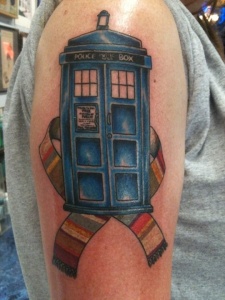
This TARDIS tattoo wraps itself in the Fourth Doctor’s iconic scarf (image Jon Reed, All Saints Tattoo Austin TX).
A TARDIS tattoo has widespread apprehensibility, yet at some point it risks becoming so commonplace that it loses its novelty. A tattoo hazards losing its claim to subcultural and artistic authenticity as well as its individual distinction if it simply reproduces a mass motif or invokes celebrity. Batman’s masked hero makes little appeal to the personality of Bruce Wayne or the actors who have played the Caped Crusader, and Star Wars provides similarly de-personalized characters like Darth Vader, Ewoks, or the Death Star. Nevertheless, in some cases it is difficult to separate a personality from a character (e.g., Heath Ledger’s Joker), and some celebrities like Marilyn Monroe may function symbolically as characters more than homages to celebrity. Doctor Who tattoos sometimes pay homage to the Doctors (e.g., the iconic fourth Doctor Tom Baker, or even all the Doctors). The most recent Doctors (David Tennant and Matt Smith) appear in some tattoos as symbols of “geek chic,” a self-consciously geek fashion that has become closely associated with both Tennant and Smith. However, as a concrete style geek chic aspires to take an unfeigned look and turn it into a superficial consumer aesthetic with no real claim to geek subculture. Unlike an original artistic motif, a popular symbol or a personality tattoo hazards losing geek consequence if its lack of aesthetic novelty undercuts the subcultural and personal meaningfulness of a tattoo.
The audience for a geeky tattoo is perhaps on some level other geeks or the uninitiated, but tattoos are not purely performative; that is, a tattoo in many ways is a soliloquy of selfhood as much as it is a display of geekhood. Tattoos establish bonds with like-minded others and materialize personal narratives, but they also are inchoate personal imaginings of who a consumer fancies themselves to be, rich evocative symbols of particular individual and social properties a consumer associates with a motif. A geek consumer articulates their sense of novelty, creativity, and personality to themselves in their commitment to a tattooed symbol that fashions themselves as “authentically” geek.
Where sci-fi, comic, and movie geeks raid popular cultural discourses for their tattoo symbols, literature geeks mine texts for quotations. Literary tattoos celebrate rich, evocative turns of phrase rather than abstract symbols, but they still have an aesthetic dimension, minimally in fonts but often in symbols paired with textual quotes. No literary tattoo seems more common than Kurt Vonnegut’s Slaughterhouse Five quote “So it Goes.” The flexible phrase appears in the book over a hundred times, and it is especially attractive as a tattoo for its succinctness (so it can appear in many different body spots), and it invokes a classic cult novel. Like popular cultural tattoos, literary geeks’ tattoos demonstrate knowledge of a text, carefully negotiating between celebrating a too-familiar quote or finding one that is overly arcane.
The stereotype of an obscure, anti-social, style-less, and isolated geek culture has been undone by a consumer culture that markets geek style to and has more overlap with popular culture than most geeks acknowledge. The projection of that style beyond narrow geek circles sometimes strikes apprehension in the imagination of geeks aspiring to preserve their sense of material and social distinction. Tattoos aspire to capture that geek symbolism in ways that preserve its distinctiveness without lapsing into the appearance of consumer homogenization. What it means to be geek is utterly dynamic, contextual, and defined in constant social interaction and negotiation within and against mass marketing. Tattoos—personal, creative, idiosyncratic, permanent—provide one mechanism anchoring geek selfhood.
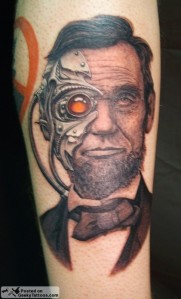
Some images take geek motifs like the Borg and project them onto other symbols, in this case creating an Abe Lincoln of Borg (image Geeky Tattoos)
References
Anders Bengtsson, Jacob Osterberg, and Dannie Kjedlgaard
2005 Prisoners in Paradise: Subcultural Resistance to the Marketization of Tattooing. Consumption, Markets and Culture 8(3):261-274.
Christina Goulding, John Follett, Michael Saren, and Pauline MacLaren
2004 Process and meaning in “getting a tattoo.” Advances in Consumer Research 31(1):279-284.
Paul Lopes
2009 Demanding Respect: The Evolution of the American Comic Book. Temple University Press, Philadelphia.
Maurice Patterson and Jonathan Schroeder
2010 Borderlines: Skin, tattoos and consumer culture theory. Marketing Theory 10(3):253–267.
Victoria Pitts
2003 In the Flesh: The Cultural Politics of Body Modification. Palgrave Macmillan, Gordonsville, Virginia.
Enid Schildkrout
2004 Inscribing the Body. Annual Review of Anthropology 33(1):319-44.
William L. Svitavsky
2001 Geek Culture: An Annotated Interdisciplinary Bibliography. The Bulletin of Bibliography 58(2):101-108.
Jason Tocci
2007 The Well-Dressed Geek: Media Appropriation and Subcultural Style. Paper presented at MiT5, Massachusetts Institute of Technology.
Anne M. Velliquette, Jeff B. Murray, and Elizabeth H. Creyer
1998 The Tattoo Renaissance: An Ethnographic Account of Symbolic Consumer Behavior. Advances in Consumer Research 25:461-467.
Rebecca Williams
2011 Desiring the Doctor: Identity, Genre, and Gender in Online Fandom. In British Science Fiction Film and Television: Critical Essays, edited by Tobias Hochscherf and James Leggott, pp.167-177. McFarland and Company, Jefferson, North Carolina.
Amy Wilkins
2008 Wannabes, Goths, and Christians: The Boundaries of Sex, Style, and Status. University of Chicago Press, Chicago.
Image
Abe Lincoln of Borg image Geeky tattoos
David Tennant image from Nerd tattoos
Doctor Who villains image Geeky Tattoos
Jack Kerouac quote from Tips for Spontaneous Prose image from contrariwise
Star Trek tattoo image Tissy Tech
TARDIS and Fourth Doctor Scarf image Jon Reed by All Saints Tattoo
Time Seal image Benchilada
Yoda tattoo image Tissy Tech
